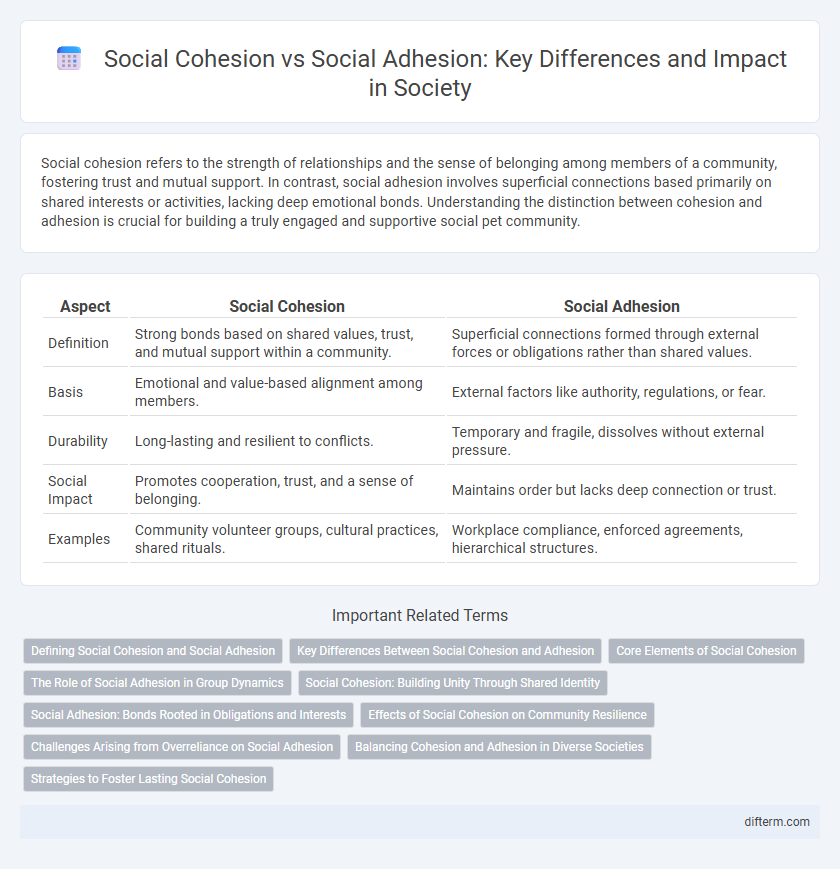Social cohesion refers to the strength of relationships and the sense of belonging among members of a community, fostering trust and mutual support. In contrast, social adhesion involves superficial connections based primarily on shared interests or activities, lacking deep emotional bonds. Understanding the distinction between cohesion and adhesion is crucial for building a truly engaged and supportive social pet community.
Table of Comparison
| Aspect | Social Cohesion | Social Adhesion |
|---|---|---|
| Definition | Strong bonds based on shared values, trust, and mutual support within a community. | Superficial connections formed through external forces or obligations rather than shared values. |
| Basis | Emotional and value-based alignment among members. | External factors like authority, regulations, or fear. |
| Durability | Long-lasting and resilient to conflicts. | Temporary and fragile, dissolves without external pressure. |
| Social Impact | Promotes cooperation, trust, and a sense of belonging. | Maintains order but lacks deep connection or trust. |
| Examples | Community volunteer groups, cultural practices, shared rituals. | Workplace compliance, enforced agreements, hierarchical structures. |
Defining Social Cohesion and Social Adhesion
Social cohesion refers to the strength of relationships and the sense of solidarity among members of a community, emphasizing shared values, trust, and cooperation. Social adhesion focuses on the superficial connections and external bonds that hold individuals together without deep emotional or communal ties. Understanding the distinction highlights how cohesive societies foster cooperation and integration, while adhesion often reflects mere association or dependence.
Key Differences Between Social Cohesion and Adhesion
Social cohesion refers to the strength of relationships and the sense of solidarity among members of a community, emphasizing shared values and collective identity. Social adhesion, in contrast, highlights the bonds that hold individuals together based on external forces or formal structures rather than genuine emotional connections. The key differences lie in cohesion's focus on mutual commitment and integration versus adhesion's reliance on compliance and superficial attachment.
Core Elements of Social Cohesion
Social cohesion is characterized by strong social bonds, a shared sense of belonging, and mutual trust among community members, which foster cooperation and collective well-being. In contrast, social adhesion relies more on superficial connections without deep emotional or normative integration, often resulting in weaker social ties. Core elements of social cohesion include social inclusion, participation, equity, and solidarity, all of which contribute to building resilient and harmonious societies.
The Role of Social Adhesion in Group Dynamics
Social adhesion functions as the emotional glue binding individuals through shared attractions and interpersonal relationships, crucial for fostering immediate social bonds within groups. Unlike social cohesion, which emphasizes collective goals and shared norms, social adhesion centers on personal connections that enhance trust and cooperation among group members. This emotional affinity facilitates smoother group dynamics by promoting solidarity and mutual support, essential for group stability and effective collaboration.
Social Cohesion: Building Unity Through Shared Identity
Social cohesion strengthens communities by fostering a shared identity that promotes trust, cooperation, and mutual support among members. It creates an inclusive environment where diverse individuals feel connected through common values and goals, enhancing collective well-being and stability. Building social cohesion is essential for reducing conflicts and encouraging collaboration in both local and broader societal contexts.
Social Adhesion: Bonds Rooted in Obligations and Interests
Social adhesion refers to the bonds that connect individuals primarily through shared obligations and mutual interests, rather than deep emotional ties. These links are often transactional, built on practical considerations such as economic benefits, social contracts, or institutional roles. Unlike social cohesion, which emphasizes collective identity and emotional unity, social adhesion relies on a framework of duties and reciprocal advantages to maintain group stability.
Effects of Social Cohesion on Community Resilience
Social cohesion strengthens community resilience by fostering trust, shared values, and mutual support among members. High levels of social cohesion enhance collective action during crises, reducing vulnerability and accelerating recovery. Communities characterized by social cohesion exhibit lower crime rates, improved mental health, and greater economic stability, which all contribute to sustained resilience.
Challenges Arising from Overreliance on Social Adhesion
Overreliance on social adhesion, characterized by superficial connections and shared external symbols, often leads to fragile group unity vulnerable to conflict and exclusion. This limited form of cohesion fails to foster deep interpersonal trust and genuine emotional bonds essential for resilient communities. Consequently, social groups may experience increased polarization, reduced cooperation, and challenges in achieving long-term social stability.
Balancing Cohesion and Adhesion in Diverse Societies
Balancing social cohesion and social adhesion in diverse societies requires fostering shared values and mutual trust while respecting individual identities and group affiliations. Social cohesion promotes collective unity through common goals and solidarity, whereas social adhesion emphasizes the bonds formed around specific interests or identities. Effective social policies encourage inclusive participation and dialogue to harmonize these dynamics, enhancing stability and integration within multicultural communities.
Strategies to Foster Lasting Social Cohesion
Effective strategies to foster lasting social cohesion emphasize inclusive community engagement, promoting shared values, and building trust through transparent communication. Implementing participatory decision-making processes and supporting cultural diversity enhances mutual respect and collective identity. Strengthening social networks and addressing inequalities are critical to transforming social adhesion into durable social cohesion.
social cohesion vs social adhesion Infographic

 difterm.com
difterm.com